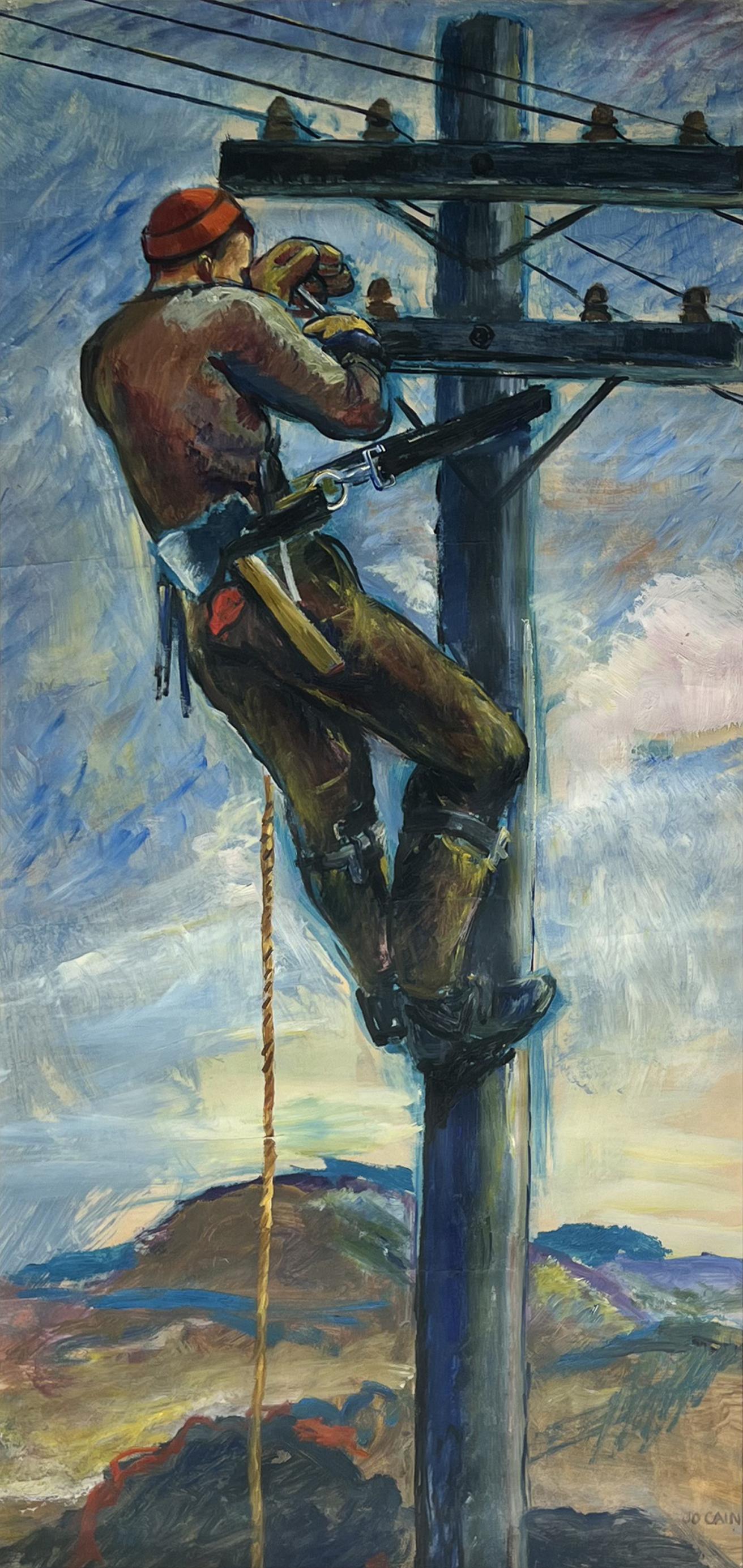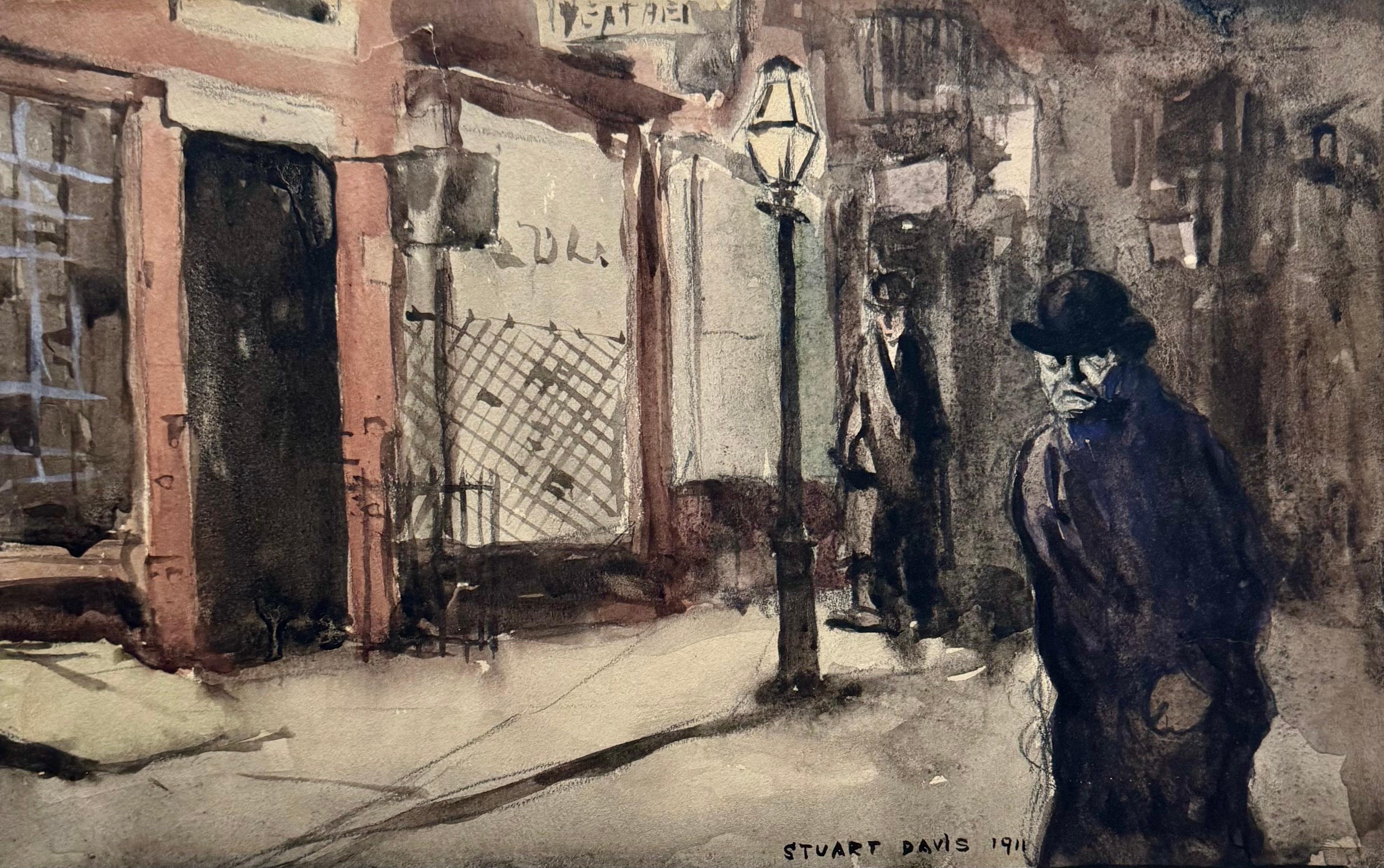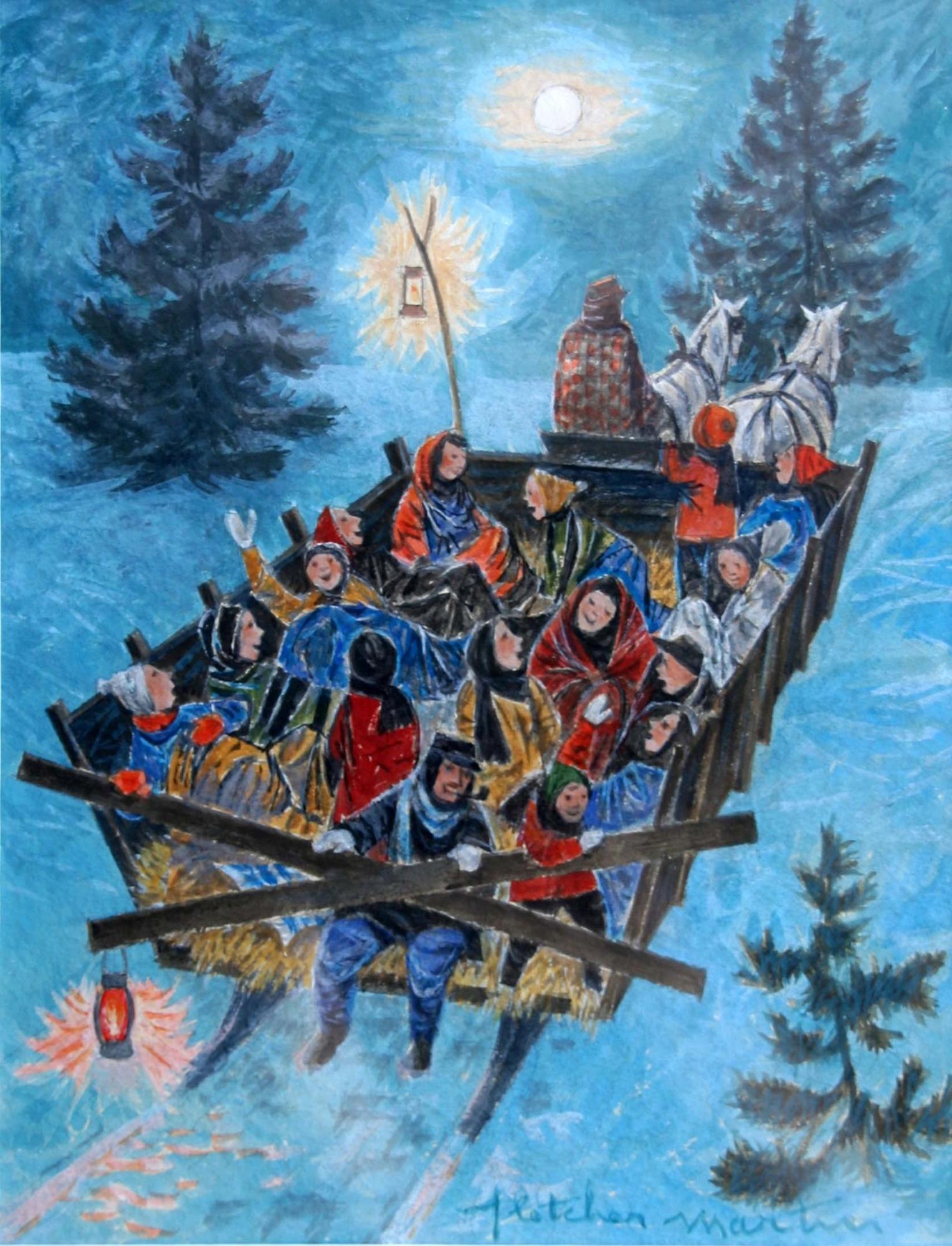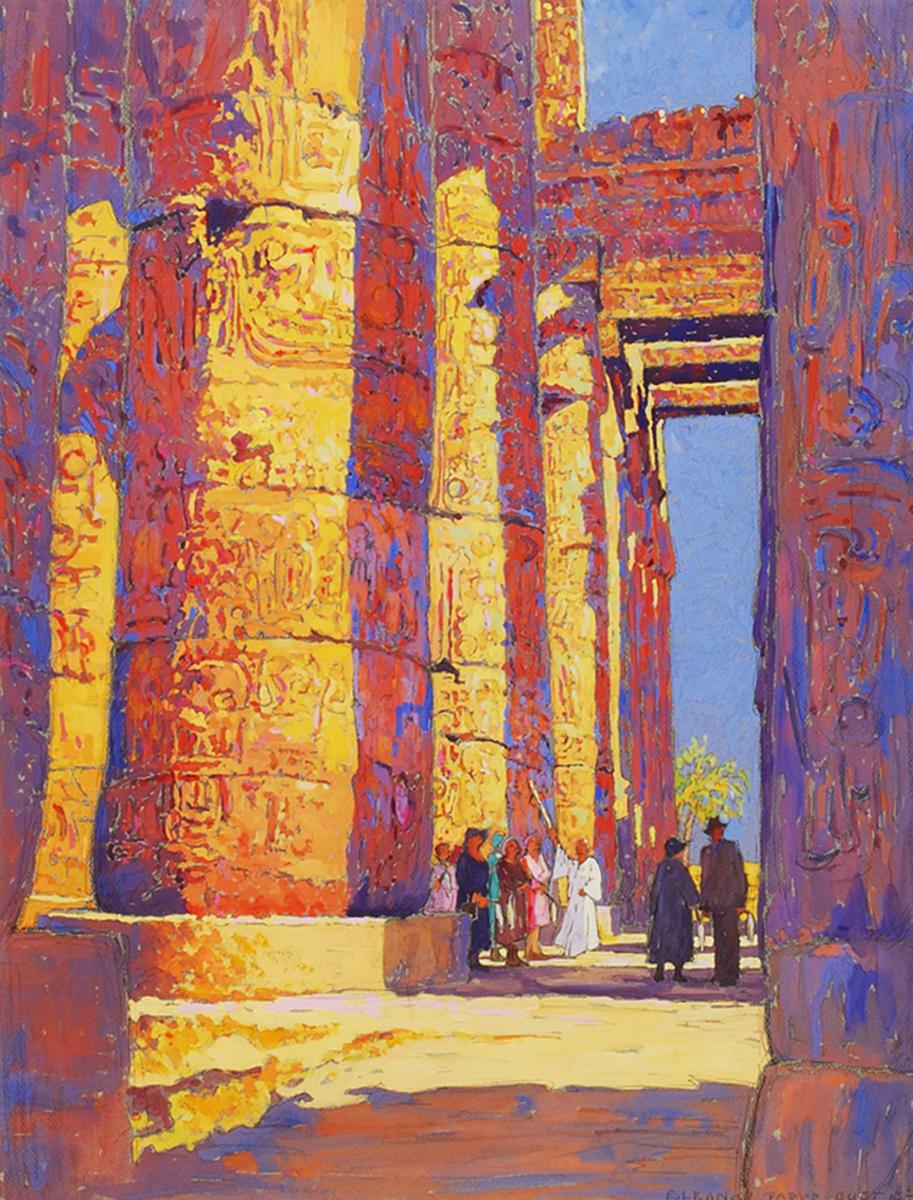Items Similar to "Backyards" Early 20th Century Watercolor Fauvism Social Realism American Scene
Want more images or videos?
Request additional images or videos from the seller
1 of 8
Stuart Davis"Backyards" Early 20th Century Watercolor Fauvism Social Realism American Scene1911
1911
About the Item
"Backyards" Early 20th Century Watercolor Fauvism Social Realism American Scene
Note: We have three similar in style works from 1911 available now on 1stDibs. All are framed identically by Bark.
The three drawings are shown together on page 452 of the Stuart Davis Catalogue Raisonne, as seen in the attached photos.
Stuart Davis (1892-1964)
Backyards
Watercolor, signed and dated 1911
Sight: 8 25/32 x 9 25/32 inches
Framed by Bark: 15 5/8 x 16 3/8 inches
LITERATURE: A, Boyajian, M. Rutkowski, Stuart Davis, A Catalogue Raisonne, Vol. 2, New Haven, Connecticut, 2007, vol. II, p. 452, illustrated.
Provenance:
Estate of Joan Bardenheier Harrison, from a proud St. Louis Family of German descent. Her family founded the John Bardenheier Wine and Liquor Company in 1873, later named the Bardenheier Wine Cellars. At its peak, the winery was one of the oldest and largest family owned and operated wineries in the United States.
BIO
Born in Philadelphia in 1892, Stuart Davis is known by many art historians as the American painter most influenced by Cubism. Art historian Norman Geske described Davis' career as a "near classical demonstration of the process by which American painting of the twentieth century came of age." (40). Davis moved from journalistic illustration to Social Realism, to Expressionism, to Cubism, ultimately becoming one of America's leading abstractionists. Strongly influenced by Fernand Leger and the New York Armory Show of 1912, he developed his own unique style of Cubism, which also incorporated Realism.
Along with Max Weber, he is credited with being the importer of Cubism to the United States from France at a time when the public was more interested in Social Realism and American Scene painting with people and places that were recognizable.
Through his painting, he pursued a life-long quest of finding a logical set of assumptions from which he could produce a modern picture, and the results were strong, related patterns and compelling color combinations. In addition to paintings, his body of work includes drawings, collages, lithographs, gouaches, and murals.
Stuart Davis was born in Philadelphia to artistic parents. His mother was sculptor Helen Stuart Foulke, and his father, Edward Wyatt Davis, was art editor of the Philadelphia Press. Through his father, he had early association with John Sloan and Robert Henri, with whom he studied in New York City from 1910 to 1913. The Armory Show of 1912 dissuaded him from following the realist styles of Sloan and Henri, but he maintained his artistic focus on aspects of the social realism they espoused in that many of his subjects were places such as run-down hotels or apartment interiors.
Davis experimented with Cubism, collage, and total abstraction, and eventually settled on a style based on Cubism with much improvisation. In the late 1920s, he lived in Paris in Jan Matulka's studio close to other modernists including Alexander Calder, Isamu Noguchi, and Morris Kantor. Then he returned to New York City, in whose vicinity he spent the remainder of his career. He had a New York City studio and also a studio in Hoboken, New Jersey. From that time, his paintings reflected American experience, especially his love of jazz music, with the modernist styles he employed beginning with the Armory Show of 1913.
In the 1930s, he taught at the Art Students League in New York, and he also did murals for the WPA (Works Progress Administration). In the 1940s, he taught at the New School for Social Research. In 1964, he received the first commission by an American artist to design a postage stamp, which was issued six months after his death in that year.
His first exhibition was in 1927 and venues included the Phillips Gallery in Washington DC , and the Whitney Museum in New York. In this exhibition, he introduced his landmark "Eggbeater Series", various depictions of an eggbeater, a fan and a glove, with each one increasingly abstract until only pure abstraction remained.
A 1998 retrospective of his work was organized by curators of the Peggy Guggenheim Collection in Venice, and its last venue was The National Museum of American Art in Washington D.C.
- Creator:Stuart Davis (1892-1964, American)
- Creation Year:1911
- Dimensions:Height: 16 in (40.64 cm)Width: 17 in (43.18 cm)
- Medium:
- Movement & Style:
- Period:
- Condition:
- Gallery Location:New York, NY
- Reference Number:1stDibs: LU1156213569612
About the Seller
5.0
Platinum Seller
These expertly vetted sellers are 1stDibs' most experienced sellers and are rated highest by our customers.
Established in 2008
1stDibs seller since 2019
164 sales on 1stDibs
Typical response time: <1 hour
- ShippingRetrieving quote...Ships From: New York, NY
- Return PolicyA return for this item may be initiated within 3 days of delivery.
More From This SellerView All
- Man Working Mid 20th Century American Scene Social Realism Industrial WPA ModernBy Jo CainLocated in New York, NYMan Working Mid 20th Century American Scene Social Realism Industrial WPA Modern Jo Cain (1904 - 2003) Telephone Pole Worker 38 1/4 x 18 1/2 inches Oil on pap...Category
1930s American Realist Figurative Drawings and Watercolors
MaterialsPaper, Gouache
- Answering the Door Early 20th Century w/c Fauvism Social Realism American SceneBy Stuart DavisLocated in New York, NYAnswering the Door Early 20th Century w/c Fauvism Social Realism American Scene Note: We have three similar in style works from 1911 available now on 1stDibs. All are framed identi...Category
1910s American Realist Figurative Drawings and Watercolors
MaterialsPaper, Watercolor
- Two Men on a Street Early 20th Century w/c Fauvism Social Realism American SceneBy Stuart DavisLocated in New York, NYTwo Men on a Street Early 20th Century w/c Fauvism Social Realism American Scene Note: We have three similar in style works from 1911 available now on 1stDibs. All are framed identi...Category
Early 1900s American Realist Figurative Drawings and Watercolors
MaterialsPaper, Watercolor
- "Going to the Festival" WPA Ashcan 20th Century American Scene Modern RealismBy Daniel Ralph CelentanoLocated in New York, NY"Going to the Festival" WPA Ashcan 20th Century American Scene Modern Realism Daniel Celentano (1902 - 1980) "Going to the Festival," 14 1/2 x 10 1/2. Watercolor on paper, c. 1930s....Category
1930s American Realist Figurative Drawings and Watercolors
MaterialsWatercolor, Paper
- "Brick Layers" WPA American Scene Mid 20th Century Modern Drawing Men WorkingBy David FredenthalLocated in New York, NY"Brick Layers" WPA American Scene Mid 20th Century Modern Drawing Men Working. 21 x 15 inches Watercolor on paper. c. 1938. Signed lower left. BIO David Fredenthal (1914 - 1958) was one ot America's most respected watercolor artists. He was famous for his bold, intensely vigorous and complex paintings and drawings that expressed his deep feeling for excitement with life and living. He was a draftsman with seemingly a special gift for catching anything, physically and emotionally on the spot, and he never went anywhere without three or four loaded pens and a sketchbook in his pocket. As part of the WPA project he executed a number of murals including the Sports Pavilion on the Heinz Building of the New York World's Fair 1939. Some of his fresco and mural techniques were inspired by his friendship with Diego Rivera who had admired and encouraged him in the early 1930's. After he won a traveling scholarship to Europe from The Museum of Modern Art at age 19, he was the recipient of two Guggenheim grants in Painting. He had his first solo exhibition at the Downtown Gallery in New York in 1937 at age 23, and many others after that including the Whitney Museum of American Art in 1947. Because of Fredenthal's prodigious drawing gifts, he was chosen by Erskine Caldwell to illustrate his novel "Tobacco Road" in 1940. He was a War Artist Correspondent for both the State Department (the European and Asian fronts) and Life magazine from 1943 to 1946 and his work was featured in Life magazine regularly during the war and after until the end of his life. Also featured in Life in 1956 were drawings that Fredenthal had vividly recorded on his sketch pad, of the entire filming of the movie, The Pride and the Passion, starring Cary Grant, Sophia Loren, and Frank Sinatra, along the treacherous mountain passes of Spain. Though he was fiercely committed to an art that expressed deeply human social values and issues and was quite hostile to abstraction, he was friendly with a number of abstract artists such as David Smith, Ad Reinhardt, Philip Guston, Paul Feeley, and Herman Cherry.Category
1930s American Realist Figurative Drawings and Watercolors
MaterialsWatercolor, Handmade Paper
- TOBACCO ROAD Mid 20th Century Realism 1940 Drawing from the Novel WPA Literary 3By David FredenthalLocated in New York, NYTOBACCO ROAD Mid 20th Century Realism 1940 Drawing from the Novel WPA Literary 3 10 1/2 x 6 (sight), Signed David Fredenthal lower right. Framed by Lowy. Offered here is one of several original drawings by WPA artist David Fredenthal that were first published in the 1940 illustrated edition of the novel TOBACCO ROAD by Erskine Caldwell. Background on the Drawing Erskine Caldwell remarked, on seeing the work of David Fredenthal, 26-year-old painter: "That boy could draw my Tobacco Road people." A casual comment, it was enormously productive. The young painter was just finishing a two-year Guggenhcim Fellowship, preceded by a year's study in Paris, two one-man shows at New York's Downtown Gallery, and a fellowship at the Cranbrook Academy near Detroit. He was out in Colorado Springs when he heard what Caldwell had said about him. Fredenthal hadn't read Tobacco Road. He had not even seen the play - now breaking all records in its seventh year on Broadway. But he swapped a portrait for a second-hand Ford and headed East. In New York he learned that Dnell, Sloan & Pearce were bringing out a deluxe edition of Tobacco Road. But he had no entrée to the publishers, and Caldwell, to his disappointment, was out of town. So he drove on to Georgia to have a look at the Tobacco Road people. He found Dr. I. C. Caldwell, the author's father, in Wrens, Ga., going on his ministerial rounds among people like the Lesters. Fredenthal got a room from a couple who ran a 1-pump filling station...Category
1930s American Realist Figurative Drawings and Watercolors
MaterialsPaper, Ink, Watercolor
You May Also Like
- "Sleigh Ride, Winter, " Fletcher Martin, Woodstock, Holiday Scene IllustrationBy Fletcher MartinLocated in New York, NYFletcher Martin (1904 - 1979) Sleigh Ride, Woodstock, New York circa 1955 Watercolor on paper 14 x 11 inches Signed lower right Provenance: James Cox Galler...Category
1950s American Realist Landscape Drawings and Watercolors
MaterialsPaper, Watercolor
- King Street, Troy (Modern Realist Cityscape in Black & White Watercolor)By Scott Nelson FosterLocated in Hudson, NYwatercolor on paper 9 x 11 inches 17 x 21 x 1 inches, brown wood artist made frame, white mat This photo-realist cityscape of Albany, NY was painted with black and white watercolo...Category
2010s American Realist Landscape Drawings and Watercolors
MaterialsArchival Paper, Watercolor
- Tourists Viewing the Temple of Karnak, EgyptBy Eleanor Parke CustisLocated in New York, NYEleanor Park Custis painted scenes as varied as the artist's travels: from her hometown of Washington, D.C., to the coastal towns of New England; from the prosperous fishing villages of Brittany, to Venice and the mountain villages and lakes of northern Italy. While Custis's subjects are diverse, her style is consistent and distinctive throughout this body of work. Her use of flat areas of color delineated by dark contours is reminiscent of the aesthetics of woodblock printing. Like many artists of the day, she was profoundly influenced by Japanese woodblock prints, and her adaptation of the aesthetic by 1924 led to her most productive artistic period. Eleanor Custis hailed from a socially prominent Washington, D.C., family. She was distantly related to Martha Custis Washington, America's first First Lady. Custis began three years of formal art training in the autumn of 1915 at the Corcoran School of Art in Washington, and was guided and inspired by Impressionist artist Edmund C. Tarbell, one of the Ten American Painters, who became the Corcoran School's principal in 1918. Custis exhibited widely in many of the Washington art societies and clubs for much of her career. She was also a frequent exhibitor at the Grand Central Art Galleries in New York City; her last one-woman show there was in April 1945. Custis's mature style emerged in scenes of the streets, wharves, and drydocks of seacoast villages from Maine to Massachusetts, which she visited during the summers of 1924 and 1925. She was working in Gloucester, Massachusetts in August 1924, and painted several gouaches of the town's wharves and winding streets, including In Gloucester Harbor and At the Drydock, Gloucester. During her stay, Custis may have met Jane Peterson or at least must have seen her work, the best of which was executed in Gloucester during the preceding ten years. The similarity between their styles is unmistakable, but, while it may be tempting to suggest that Custis was influenced by Peterson during her summer in Gloucester, the connection between their work is probably more a case of shared aesthetics and common European influences. Custis expanded her subject repertoire with three trips to Europe between 1926 and 1929, and was inspired by the Old World charm of Holland, northern France, Switzerland, and Italy, leading to such works as New Kirk, Delft, Holland, Market Day in Quimper, At the Foot of the Matterhorn, and The Town Square, Varenna. A Mediterranean cruise in 1934 introduced her to the Near East, and the bustling, colorful streets and bazaars of Cairo, captured in works like A Street in Cairo, Egypt and A Moroccan Jug...Category
20th Century American Realist Landscape Drawings and Watercolors
MaterialsPaper, Gouache
- Mid-Century Hillside Trees Landscape Watercolor (unfinished)By Joseph YeagerLocated in Soquel, CABeautiful mid-century landscape watercolor with a tall, stately tree in the foreground, its many forking branches depicted with exceptional detail, and a verdant background of rollin...Category
Mid-20th Century American Realist Landscape Drawings and Watercolors
MaterialsPaper, Watercolor
- Mid Century Mazatlan Beach Catamaran Figurative Landscape WatercolorBy William A. CorbettLocated in Soquel, CAVibrant figurative seascape of a beach in Mazatlan, Mexico with several figures and a catamaran reflecting beautifully in the shallow water by William A. Corbett (American. 1914-1960). Titled "Beach- Mazatlan" on verso. Signed "William Corbett" in lower left corner. Presented in a simple wood frame, with a double mat of off-white silk and royal blue with plexiglass. Image size: 22”H x 14.75”L William A. Corbett began drawing at an early age. He constructed signs and displays for theaters and nightclubs around Pittsburg. He studied art with Vincent Nesbert at the Pittsburg Art Institute and with Robert Gwathmoy, Roy Hilton, and Robert Laper at the Carnegie Institute of Technology. He also studied painting and sculpture at the Louisville Art Center. Corbett was in the Army Engineers at Fort Knox, Kentucky where he studied, practiced, and had exhibits with army artists there from 1941-1943. He was very much interested in materials and technique, content and style in painting. His favorite Artists were El Greco, Leonardo, Rembrandt, Renoir, Burchfield, and Andrew Wyeth, Jr. He studied two years at Boston museum School with Karl Zerbe, Daivid Aronson and others. He later designed and did art work for General Outdoor Advertising Co. In 1943, he married Ruth Osborne of Louisville and they had one son, Michael. In 1951 he moved to Fort Lauderdale, Florida with his family. Exhibitions: Army Art Show--- 1st Prize in Landscape, 1942 Kentucky & southern Indiana Exhibition-- Honorable mentions for Fisherman's Curse 1949, Don Q...Category
1960s American Realist Landscape Drawings and Watercolors
MaterialsPaper, Watercolor
- Santa Cruz Boardwalk Railroad Trestle Bridge, Vintage Figurative LandscapeLocated in Soquel, CAVintage mid-1970's landscape watercolor of small figures on the famous Santa Cruz Boardwalk Railroad Bridge by Laura Manss Matarazzo (American, b...Category
1970s American Realist Landscape Drawings and Watercolors
MaterialsPaper, Watercolor
Recently Viewed
View AllMore Ways To Browse
Joseph Goldberg
British Scottish River Garry
Kate Sherman
Kelly Spirit
Set Three Charcoal Drawings
Antique English Oil Painting Of Horse
George M Stone
Venice Xviii
Gun Telephone
Adoration Of Magi
Moscow Red Square
Red Square Moscow
Pluto Sculpture
Hockney Swimming
Bronze Uri
The Young America Clipper
Karl Otto Gotz
Golden Skull





